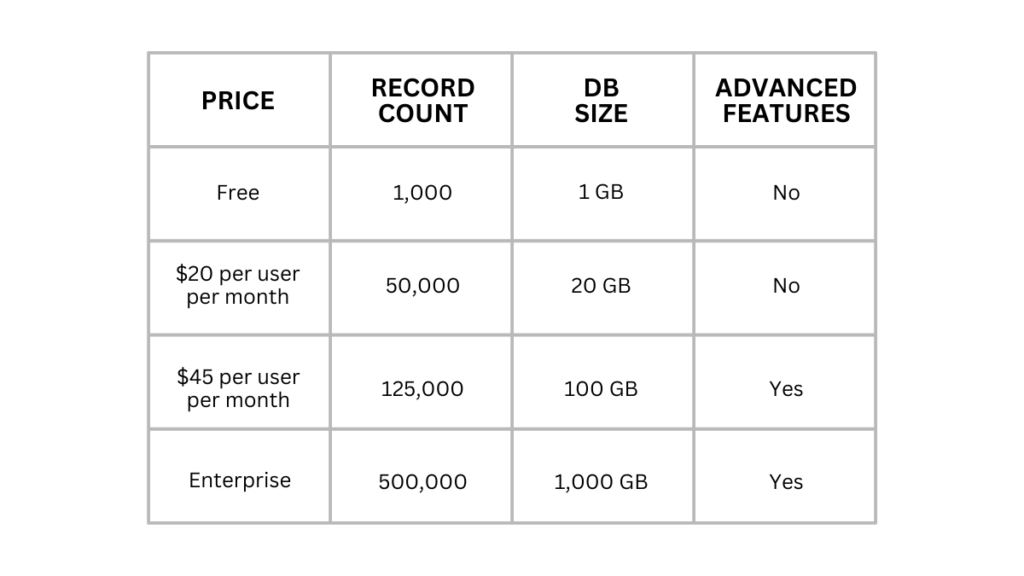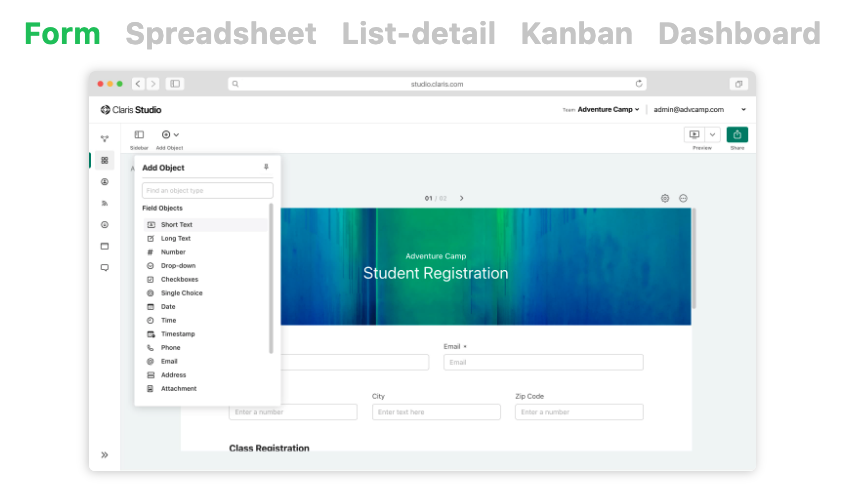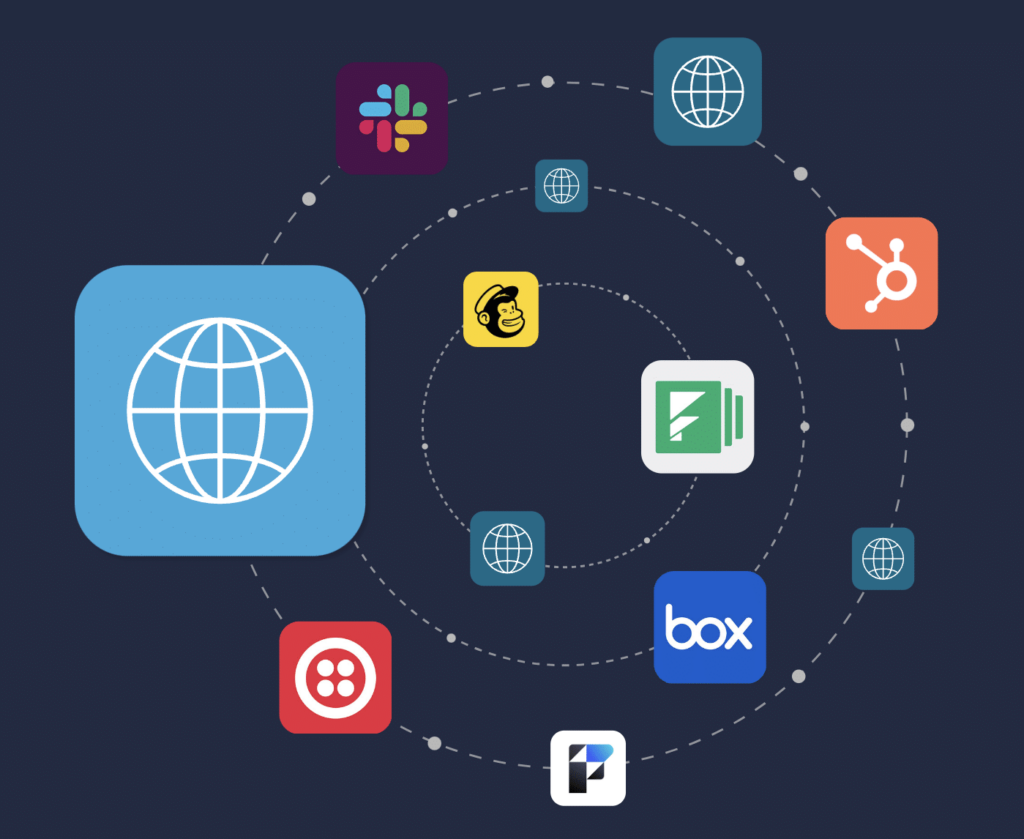We first posted a review of FileMaker vs Airtable a little over four years ago. We’re circling back around to take another look and have updated this article accordingly. While Airtable has lots of strengths and works well in many circumstances, we remain confident that FileMaker takes the lead with its flexibility and broad range of customization possibilities.
How Does FileMaker Compare to Airtable?
FileMaker Pro is a versatile and powerful development environment and it enables us to create great applications for our clients. With the flexibility of WebDirect, we can create a web browser interface for our clients very quickly – much more quickly than we can create a traditional web application using JavaScript or other methods.

That said, we realize there are a variety of other tools available today for rapidly creating a web-based data management tool that a potential database customer might want to consider, including Airtable.
Airtable is like many SaaS (software as a service) systems – it’s solely web-based. It requires you to create an account for each user and offers multiple tiers to choose from, starting with a free tier. (This option is something FileMaker Pro currently lacks, other than its 45-day trial.) For an extremely simple solution, Airtable’s free version might suffice and it’s hard to beat free.
Pricing Structure Considerations in FileMaker vs Airtable
From my experience, it looks to me like many FileMaker users would end up at the $45 per user per month level due to any of the following reasons:
- Large database
- Many of our clients have more than 20GB of data when you take into account images and attachments.
- More than 50,000 records
- Most of our clients have at least one table with that many records in their solutions.
- External user authentication
- Active Directory, Google, Microsoft, Okta, etc.
- More complex data synchronization (syncs) between numerous Airtable databases

There are other database aspects, as well, that push users into the $45 per month or higher tier. A moderately complex, on-premise system with ten users would run about $5,400 per year in Airtable. Comparatively, FileMaker licensing for a similar solution would be about $1,800 per year. If hosted in the cloud, that cost would bump up to around $3,600 annually.
- Keep in mind these figures are ballpark ones, as there are several variables involved with pricing.
- We are experienced Claris resellers and would be glad to provide more detailed information that pertains to your specific licensing needs.
FileMaker Allows for On-Premise and Standalone Options
With Airtable, there is no option to host your own server (‘on premise’, in technical jargon). An Airtable account is required to work with your data. If you decide to stop using Airtable, you will need to export your data in some way and build a new tool for interacting with your information.
With FileMaker, you can choose to manage your own server for security or cost reasons. You can also purchase a standalone copy of FileMaker to continue to use your solution as a single-user application offline if needed for legacy or archival purposes.

FileMaker Has Capabilities Beyond an Assortment of Templates
Airtable has a rather impressive array of templates, neatly organized into categories, that can be built upon if your needs match one of the scenarios. A few of the examples include event management, legal case analysis, and video production management. With such a large number of templates available, it’s hard to imagine that many companies would build an Airtable solution completely from scratch.
With a template selected, you can start entering data and modifying the template but it’s in this process that a FileMaker user like myself starts to see the restrictions of Airtable. You have very limited ability to design your layouts exactly the way you would like and you don’t have FileMaker’s scripting environment to manage and control how the application behaves.
In recent years, Airtable has added an automation feature that lets you trigger actions based on events that occur in your solution – like sending an email for example. While not as flexible as FileMaker’s scripts or script triggers, they are easy to implement.
If your needs are straightforward, Airtable does a good job of presenting you with a quick and clean user interface for editing and listing your data.
With FileMaker you’re not limited in design and layout. Everything is fully customizable plus the integration possibilities are endless, as I’ll talk about later in this article.

Claris Studio is Gaining Ground in Providing Simple-to-Create Web Forms
Airtable has a nice feature for converting a data entry screen to a web form that you can then send to someone as a URL. This ability allows even someone without an Airtable account to fill out and submit some data. Once submitted, the data is not editable by the person who submitted it, but the process could still be very useful in some circumstances.
With FileMaker, my early use of Claris Studio shows its promise in delivering the above functionality for its users. I look forward to seeing Claris Studio’s capabilities evolve in the future.


REST API & Data Exports are Available in Each System
The data in Airtable can be accessed via a REST API and data can also be exported in CSV format. Either of these methods could be used to move your data out of Airtable if you start using the program but later decide to move your data elsewhere. The REST API could even be used to integrate an Airtable application with FileMaker.
The FileMaker Data API allows your data in FileMaker Server to be accessed from any REST client application. You can write your own API to tightly control data access, or leave the API open for more general access. FileMaker also supports the export of data in a variety of formats including CSV, tab-delimited, and Excel.

Internet Access is a Given, Plus FileMaker Go Adds an Offline Functionality
Solutions in both Airtable and FileMaker can be accessed over the internet from your mobile device, with various limitations for both platforms. FileMaker Go adds the option for FileMaker developers to create an offline version of their app that can function on iOS devices even when Internet connectivity is unavailable.

FileMaker Can Integrate With Virtually any API, Plus Provides Custom Scripting Flexibility
Airtable has a modest number of built-in integrations that you can use to do things like post a message to a Slack channel or process a payment via Stripe. While the list of integrations isn’t great, if what you want to do is supported, it is quite easy to implement.
FileMaker has the expanded ability to integrate with virtually any third-party API via its scripting language or the growing offerings of Claris Connect. Custom connectors can even be built when existing APIs or connectors need to be stretched a little further.

Integrations are one of our specialties as we’ve seen the power they hold to streamline processes and make your businesses run smoothly. It’s important to us to continue to expand our knowledge of this area, to provide you with the best input and advice for the work you need to accomplish. We’ve written about connectors extensively and have provided an assortment of articles for your further learning.
- Visit the Claris Marketplace to download a free custom connector that we created for use with Xodo Sign
- See How To Utilize the New Custom Connectors In Claris Connect
- Learn about a Shopify integration we did for our longtime client, Haversack Sales.
- Take some time to read through a selection of our articles about Claris Connect:
- 5 Ways To Maximize The Free Tier Of Claris Connect
- Integrating Claris Studio And FileMaker Server Using Claris Connect
- Comparing Claris Connect and other iPaaS Systems
- Claris Connect – Callback URLs in FileMaker Triggers
- Claris Connect – First Impressions
- VIDEO: Claris Connect – Using the Stripe Connector
- VIDEO: Claris Connect – Handling Events With Outlook
- VIDEO: Claris Connect – QuickBooks Intro
FileMaker Provides a Development / Sandbox Environment
In one of our weekly staff dev meetings, a key difference between FileMaker and Airtable came to light. FileMaker’s architecture and licensing allow for a fairly standard setup of development and production environments (servers) that allow a development version of the application to be modified and tested before changes are deployed to the production server. We rely heavily on this approach to help ensure our clients have the smoothest FileMaker experience possible.
Airtable does not have a development/sandbox environment to support this recommended deployment model. A snapshot and restore function does allow you to test something and then restore the database to an earlier version, but this arrangement lacks the preferred flexibility.
FileMaker’s licensing includes the right to install up to three copies of FileMaker Server, so the dev/production approach is fully supported within that licensing model.
Some Other Key Areas in the FileMaker vs Airtable Discussion
A few other areas stood out for me while looking at Airtable.
- Printing
- Audit tracking
- Standardized navigation
- Images
A significant drawback of Airtable is found in its printing limitations. If you need to faithfully reproduce a printed form, create a complex multi-page printed report or PDF, or a moderately customized invoice printout or PDF, Airtable requires the use of 3rd party tools, extensions, or export to a 3rd party product.
Airtable has a default capability for tracking changes to your data, which can be extremely helpful at times. While this data change history (auditing) can be done in FileMaker, there are limitations and it isn’t as easy or automatic as in Airtable.
Airtable automatically provides a nice, standard navigation interface for moving between your data tables without the user having to implement anything. FileMaker lacks this default but stands out for its ability to allow customization of the user interface, including the navigation experience. We use a standardized navigation template in most of our FileMaker solutions, and FileMaker also has additional sample interfaces in its template files.
Airtable does allow you to attach images. However, FileMaker may be better suited in the image handling category due to its innate scripting language. It provides better capabilities for customization, especially if the file sizes are large or there are a lot of images.
FileMaker Takes the Lead With Flexibility and Customization
This review isn’t meant to be exhaustive – it represents just a few hours of experimenting and discussing Airtable. That said, I can see Airtable would be a pretty good solution for a workgroup that wants a predefined data management solution that requires minimal time to get up and running and isn’t expected to require extensive customization.

But when you start looking at customizability and flexibility, FileMaker comes out strongly ahead in my opinion. Its layout editor and scripting environment provide a great deal more control than is available in Airtable. Plus your options for integration, and making the database exactly what you want, are nearly limitless.
We’re Here to Bring Your Database to Life
With the shifts in today’s workplace, it is more important than ever to help your staff be as productive as possible. With more than thirty years of custom application development experience, we know the ins and outs of FileMaker and how to make it sing! We are ready to help maximize the value of your investment, improve workflows, and allow your team to get more done in less time. Send us a message or schedule a call today.
FAQ
AirTable is appreciated for its simplicity and spreadsheet-like interface, making it very accessible for those familiar with spreadsheets. It offers a user-friendly experience with a minimal learning curve. FileMaker, while also offering an intuitive interface, includes a visual database modeler and comprehensive features, which might seem complex at first but provide powerful functionality for various use cases.
The cost of using FileMaker and AirTable is roughly similar, with plans generally around $20 per user per month, though exact costs can vary depending on additional features and hosting options. FileMaker may involve additional costs for hosting services, whereas AirTable is typically less expensive if hosting isn’t required.
FileMaker excels in creating complex, custom applications and offers extensive options for data modeling, security, and integration with external databases and APIs. AirTable, while user-friendly and effective for simpler database needs, lacks the depth in customization and security features that FileMaker offers, making FileMaker the better choice for more sophisticated enterprise needs.
FileMaker provides options for both cloud-based and on-premise hosting, allowing greater control over data management and security. AirTable does not offer an on-premise option; it is entirely cloud-based, which may limit control over data hosting and security compared to FileMaker.
Both platforms offer API access for integration. AirTable’s integration capabilities are straightforward and cater to common applications like Slack and Stripe through pre-built blocks. FileMaker provides more robust integration options, supporting custom scripts and connections to virtually any API, making it more versatile for complex integrations.
About the Author
John Newhoff’s business background and years of database design, computer, and network configuration, and troubleshooting experience allow him to see beyond the immediate problem to the long-term solution. John is the business manager of Portage Bay and our lead 4th Dimension developer, creating sophisticated cross-platform solutions.
